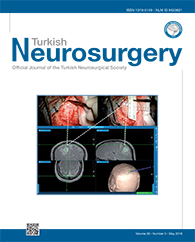2West China Hospital of Sichuan University, Department of Neurosurgery, Chengdu, China DOI : 10.5137/1019-5149.JTN.19342-16.0 AIM: To explore the clinical value of bone flap creation and the sinus protection in the approach of retrosigmoid keyhole craniotomy with the guidance of three-dimensional (3D) sliced computed tomography (CT) reconstruction of the skull transverse sinus and sigmoid sinus groove.
MATERIAL and METHODS: The scalp tracings of the transverse sinus and sigmoid sinus groove of 108 posterior fossa lesion patients were delineated by gentian violet, which relies on the relationship between its 3D reconstruction location and scalp marker. The craniotomy was executed with the guidance of its surface tracings. The intraoperative findings of exposure and damage of transverse sinus, sigmoid sinus, morphology, stability, complications, and postoperative appearance of bone flap restoration were evaluated.
RESULTS: Morphological analysis of the transverse-sigmoid sinus groove showed right superiority, left superiority, and balanced type in 61, 18, and 29 cases, respectively and the relationship between the asterion and the transverse-sigmoid sinus groove showed that asterion sites were located in the upper portion, onto, and below the transverse and sigmoid sinus groove in 19, 68, and 21 cases, respectively. Good intraoperative exposure without damage of transverse sinus and sigmoid sinus, good stability and appearance of bone flap restoration, and no postoperative pseudomeningocele were obtained after using this method to locate the transverse sinus and sigmoid sinus.
CONCLUSION: The 3D sliced CT reconstruction of the skull transverse sinus and sigmoid sinus groove was helpful in the approach of retrosigmoid craniotomy for sinus exposure, sinus protection, and the prevention of cerebrospinal fluid leakage and pseudomeningocele.
Keywords : Retrosigmoid approach, Sigmoid sinus, Transverse sinus, Three-dimensional sliced computed tomography reconstruction




